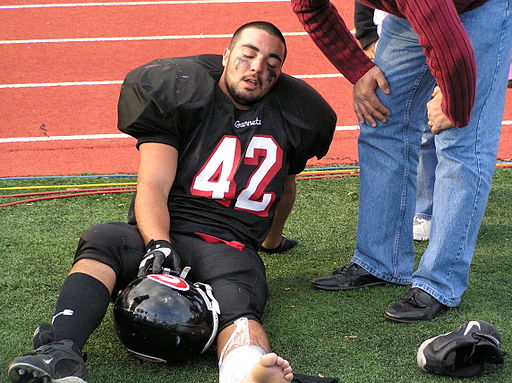CTE: the not so known effect of constant head trauma

Due to the constant head trauma that football players experience, they are at risk for developing CTE in the future. Anthony22 at English Wikipedia, CC BY-SA 3.0
February 17, 2021
Chronic traumatic encephalopathy, CTE for short, is a degenerative brain disorder that is caused by repeated head trauma such as concussions and subconcussive impacts- blows to the head that do not show any other symptoms.
Those that are involved in activities that involve frequent head trauma, such as football players, boxers, and those in the military are at risk for CTE. A proper CTE diagnosis can only be made after the patient has died by examining their brain tissue.
Symptoms of CTE include cognitive impairment, memory loss, depression, suicidal thoughts and emotional instability. All symptoms of CTE develop years after constant head trauma. A person should see a doctor if they start to have “suicidal thoughts, memory problems, personality or mood changes.”
Although athletes that experience repeated head traumas are most at risk for developing CTE later in their life, not all those that experience constant head trauma will develop CTE. Also, one concussion and “occasional” head traumas are not known to cause CTE.
Currently, there is no cure or treatment that is directed to CTE. Current CTE treatment includes treating each symptom with “targeted therapies.” For example a person that has mood and personality changes, along with other CTE symptoms, will be given treatment to target the mood/personality changes.
The current recommendation to prevent CTE is to reduce mild traumatic brain injuries and prevent additional injury after a concussion.
Those that have CTE also may have other neurodegenerative diseases, such as “Alzheimer’s disease, amyotrophic lateral sclerosis (ALS or Lou Gehrig’s disease) Parkinson’s disease or frontotemporal lobar degeneration (frontotemporal dementia)” which would also have to be treated for along with CTE.
CTE and dementia also play hand and hand. Those that have repeated traumatic brain injuries in their earlier years of life “are two to four times more at risk of developing dementia in late life.”
Repeated head trauma can be associated with a popular American sport: American football. In American football, players are constantly experiencing head trauma and other head injuries, like concussions, making them vulnerable to developing CTE in the future.
Not having constant head trauma would be the best thing to do to prevent CTE. However, this may not be simple for those that see American football as a passion or a job.
Although there is no guarantee that CTE won’t develop in any football players, there are some things players can do to prevent CTE. This includes making sure that the helmet fits properly, as an “improper fit of the helmet can increase concussion symptom severity and duration.”
How football players tackle each other would also have to change. Instead of having head to head tackling contact, football players can tackle each other in a way that the shoulders is the area that players come in contact with each other.
In order to decrease cases of CTE, how American football, and other instances in which participants are exposed to constant head trauma, have to change. Doing this will not only decrease cases but it will also prevent people from experiencing the difficulties that CTE brings.







